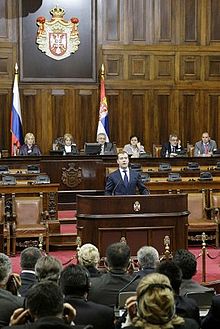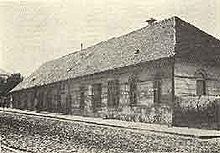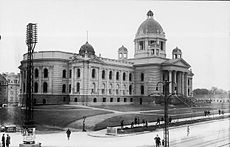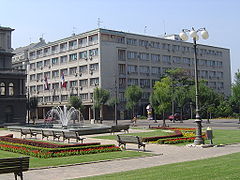- National Assembly of Serbia
-
National Assembly of Serbia
Народна скупштина Србије
Narodna skupština Srbije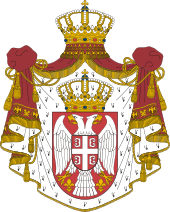
Type Type Unicameral Leadership President Slavica Đukić Dejanović, (SPS)
since 25 June 2008Structure Members 250 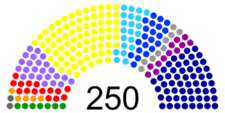
Political groups ZES (78)
Independent (2)
SRS (56)
URS (24)
DSS (21)
SNS (21)
SPS & JS (15)
LDP (12)
NS (9)
Ethnic Minorities (7)
PUPS (5)Elections Last election 11 May 2008 Meeting place 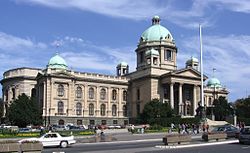
Dom Narodne Skupštine, Belgrade Website www.parlament.rs The National Assembly of Serbia (Serbian: Народна скупштина Србије or Narodna skupština Srbije) is the unicameral parliament of Serbia. It is composed of 250 proportionally elected deputies elected in general elections by secret ballot, on 4 years term. The National Assembly elects the President of the National Assembly (speaker) who presides over the sessions.[1] The current president is Slavica Đukić Dejanović since 25 June 2008.
The National Assembly exercise supreme legislative power. It adopts and amends the Constitution, elects Government, appoints and dismisses Constitutional Court judges, president of the Supreme Court of Cassation, Governor of the National Bank of Serbia and other state officials. All decisions are made by majority vote of deputies at the session at which majority of deputies are present, except for amending the Constitution, when two thirds majority is needed.[2]
The National Assembly convenes in the building called Dom Narodne Skupštine (House of the National Assembly) in Belgrade.[2]
Contents
Role
The role of the National Assembly is defined by the Constitution of Serbia, articles 98-110.[1] The National Assembly is the supreme representative body and the holder of constitutional and legislative power in Serbia.
Competencies
National Assembly:[2]
- adopts and amends the Constitution;
- decides on changes concerning the borders of Serbia;
- calls for the national referendum;
- ratifies international contracts when the obligation of their ratification is stipulated by the Law;
- decides on war and peace and declares state of war or emergency;
- supervises the work of security services;
- enacts laws and other general acts;
- gives prior consent to the Statute of the autonomous province;
- adopts defense strategy;
- adopts development plan and spatial plan;
- adopts the budget and end-of-year balance, at the government’s proposal;
- grants amnesty for criminal offenses.
- elects the Government, supervises its work and decides on expiry of term of office of the government and ministers;
- appoints and dismisses Constitutional Court judges;
- appoints the president of the Supreme Court of Cassation, court presidents, public prosecutors and judges;
- appoints and dismisses the Governor of the National Bank of Serbia and supervises his/her work;
- appoints and dismisses other officials stipulated by the Law.
The National Assembly also performs other functions stipulated by the Constitution and Law.
Parliamentary elections
Serbia 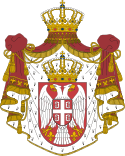
This article is part of the series:
Politics and government of
SerbiaConstitutionParliamentJudiciaryDivisionsLocal government
Parliamentary elections are regulated by the Constitution.[1] The elections are held after the four-year term of the previous assembly has expired, but can also be held before that if the Assembly dismisses the Government or the Government resigns and no majority can be reached to elect new Government. Elections are called by the President of Serbia 90 days before the end of the term of office of the National Assembly, so that elections are finished within the following 60 days. Elections are closed party-list proportional. The whole country is one electoral district. 250 seats are than distributed between the lists using d'Hondt method. There is a minimum voting threshold of 5%, so that only the party lists which get more than 5% of the votes are awarded the seats. There is no threshold for the ethnic minority lists.
After the elections, the first session of the new Assembly is convened by the Speaker from the previous convocation, so that the session is held not later than 30 days from the day of declaring the final election results.[2]
Deputies
The National Assembly is composed of 250 deputies called Narodni poslanici (Народни посланици) in Serbian. At least 30% of the deputies are women. Deputy may not be a deputy in the Assembly of the autonomous province, nor an official in bodies of executive government and judiciary, nor may he or she perform other functions, affairs and duties, which represent a conflict of interest.[2]
Deputies enjoy parliamentary immunity.
President and Vice-Presidents
By means of majority votes of all deputies, the National Assembly elects the President of the Assembly (speaker) and one or more Vice-Presidents (deputy speakers), usually one vice-president from each parliamentary group. The Speaker of the National Assembly represents the National Assembly, convokes its sessions, presides over them and performs other official activities. The vice-presidents assist the President in performing the duties within his/her purview.
In case the speaker is temporarily absent, one of the Vice-Presidents designated by him/her stands in for him/her. If the speaker does not designate any of the Vice-Presidents to stand in for him/her, the oldest Vice-President shall stand in for him/her.[2]
The Secretary of the National Assembly is appointed by the National Assembly. Secretary of the National Assembly assists the President and Vice-Presidents in preparing and chairing sittings. His/her term of office is terminated upon the constitution of a newly elected National Assembly, while he/she shall continue discharging his/her duties until the appointment of a new Secretary.[2] Secretary is not elected from the deputies, and is not member of the Assembly.
Parliamentary groups
Parliamentary groups in the National Assembly are formed not later than seven days after the date of the election of the National Assembly Speaker. A parliamentary group comprises the deputies of one political party or organisation, that has at least five deputies. A parliamentary group of at least five members may also be established by the association of deputies belonging to several political parties ore other political organisations that have less than five deputies each. A Parliamentary group is represented by the Group Head. A Group has its Deputy Head, who stands in for the head in case of his/her absence. During a National Assembly sitting, a Parliamentary group may authorise one of its members to represent the Group in relation with a particular item from the agenda. When new members join a parliamentary group, the group Head shall communicate to the National Assembly Speaker their signed statements of accession.[2]
The Parliamentary groups usually, but not necessary, correspond to the electoral party lists. Sometimes deputies from two or more lists join to form one group, but more usually members of one list, who joined together before the elections just to pass the threshold, split into two or more Parliamentary groups.
Sessions
The first session of the new Assembly is convened by the Assembly Speaker from the previous convocation. The first sitting of the National Assembly is chaired by the oldest deputy. He/she is assisted in his/her work by the youngest deputy from each of the four party lists that polled the largest number of seats, and by the Secretary of the Assembly from the previous convocation. At the first sitting of the National Assembly the President of the Assembly, Vice-Presidents and the members of the working bodies of the National Assembly are elected and the Secretary of the National Assembly is appointed.
The National Assembly is convoked for two regular sessions per year, starting on the first workdays of March and October. The Assembly is convoked for extraordinary session at the request of at least one third of the deputies or the request of the Government, with previously determined agenda. The National Assembly can be convoked without announcement upon the declaration of the state of war or emergency. The proposed agenda for a National Assembly sitting is prepared by the speaker. A quorum for the work of the National Assembly exists if a minimum of one-third of deputies are present at the National Assembly sitting. The quorum for the work of the National Assembly on Voting Days exists if at least 126 deputies are present at the sitting.[2]
The right to propose laws, other regulations and general acts belongs to every deputy, the government, assemblies of autonomous provinces or at least 30,000 voters. The Ombudsman and National Bank of Serbia also have the right to propose laws falling within their competence. Upon the request of the majority of all deputies or at least 100,000 voters, the National Assembly may call a referendum on issues falling within its competence.[2]
The National Assembly adopts decisions by majority vote of deputies at the session at which majority of deputies are present. The deputies vote “For” a motion, “Against” a motion, or abstain from voting.[2]
If the Assembly is in crisis, The President of the Republic may dissolve the National Assembly, upon an elaborated proposal of the government. The government may not propose dissolution of the Assembly, if a proposal has been submitted to dismiss the Government. The National Assembly is also dissolved if it fails to elect the Government within 90 days from the day of its constitution. The National Assembly may not be dissolved during the state of war and emergency. The National Assembly, which has been dissolved, only performs current or urgent tasks. In case of declaration of the state of war or emergency, its full competence is reestablished and lasts until the end of the state of war, that is, emergency.[2]
Acts
Acts passed by the National Assembly are:[2]
- laws;
- budget;
- development plan;
- spatial plan;
- financial statement;
- Rules of procedure;
- declarations;
- resolutions;
- recommendations;
- decisions;
- conclusions; and
- authentic interpretations of the acts it passes.
The Rules of Procedure of the National Assembly of Serbia regulate the organisation and work of the National Assembly and the manner in which the deputies’ rights and duties are exercised.[2]
Committees
Committees are standing working bodies of the National Assembly established to consider and review issues falling within the purview of the National Assembly, to propose official documents, as well as to carry out reviews of policies pursued, and laws, by-laws and other regulations implemented by the Government, to be done by each Committee for the field that falls within its purview; and also to perform other duties foreseen by the Rules of Procedure. There are 30 standing Committees, and each Committee may, from its midst, appoint one or more sub-committees to consider certain issues from its purview.[2]
Before being considered by the National Assembly, a bill is considered by competent Committees and the Government, if it is not the submitter of the bill. In their opinion, the Committees and the Government may propose that the National Assembly accept or reject the bill.[2]
Parliamentary Groups nominate members for each Committee proportionally to the number of deputies they have at the National Assembly. The proposed candidate list for Committee members is voted on as a unit, by open voting.[2]
History
1804-1918
The first Act of the National Assembly of Serbia was passed on 28 October 1858. Based on this Act, the St. Andrew's Day Assembly was convened, and held from 30 November 1858 to 31 January 1859 in Belgrade. Thus the institution of the national assembly was made legal, and foundations were laid for a system of popular representation in Serbia.
Common-law assemblies were held from the beginning of the 19th century until 1858. They were convened either by the Prince or by the Council whenever they saw fit. They were also held during the First and Second Serbian Uprisings, from 1804 to 1815. The participants in these assemblies, except for a few rare cases, were invited by the Prince or by the Council, rather than elected by the people. Common-law assemblies were almost always held under the open sky, and thousands of people would attend. At one of them, the Sretenje Assembly, held on the day of the Serbian Orthodox Church religious holiday Sretenje (Presentation of Jesus), the first Serbian constitution – Sretenje Constitution – was ratified. In early September 1842, the "Defenders of the Constitution" (ustavobranioci) headed by Toma Vučić-Perišić, aided by the assembly, deposed Prince Mihailo and put Aleksandar Karađorđević in his place. Sixteen years later, at the St. Andrew's Day Assembly, they performed a dynastic coup and returned the Obrenović dynasty to the throne.
According to the Act on the National Assembly passed at the St. Andrew's Day Assembly, the Assembly was named "The Serbian National Assembly". It kept this name until it ceased to exist in 1918. Serbian constitutions of 1835, 1869, 1888, 1901 and 1903 provide for a National Assembly as an institution and regulate the question of its work. Unlike them, the 1838 "Turkish" Constitution does not even mention a National Assembly.
According to the Acts on the National Assembly passed by Prince Miloš Obrenović (1860) and Prince Mihailo Obrenović (1861), the National Assembly was to meet every three years. The Assembly could be either ordinary or great. The great assembly was two or four times larger, according to the number of deputies, than the ordinary one. It was usually called when questions such as electing the Prince (or King) or changing the Constitution needed to be solved. Voting in the Assembly could either be individual (by name), by deputies' sitting or standing, or by secret ballot. Voting by name was administered when final texts of Acts were considered, and whenever the Government or at least twenty Deputies demanded it. Assembly officials were elected by secret ballot. The convening, opening, concluding, postponing, prolonging and dissolving of the Assembly were prerogatives of the Prince (or King). Assembly sittings were opened by the Prince's (or King's) Speech, responded to by the Assembly with the address.
Chairmen and Deputy Chairmen of the National Assembly were for a time elected by the Prince (or King) from among six candidates proposed by the Assembly; according to the 1888 and 1903 Constitutions, they were elected by the Assembly itself from among its members. One Deputy was elected for a set number of taxpayers. Initially, one Deputy was elected for 500 taxpayers, then for 1000, then 2000, and finally for 4500 taxpayers. This electoral formula determined the number of Deputies in the Assembly. At the St. Andrew's Day Assembly there were 437, and later the number oscillated between 120 and 160. Great National Assemblies could number more than 600 Deputies.
Suffrage was held by every native or naturalised Serb over 21 years of age and paying tax on his estate, work or income. Women did not have suffrage. Until 1888, public voting was practiced at elections for Deputies. The voter would publicly declare "whom he wanted for Deputy" at the polling station. The votes were noted and tallied. Secret ballot was introduced in the 1888 Constitution. It was performed with little balls. Apart from the Deputies elected by the people, the Assembly was also made up, according to the 1869 Constitution, of Deputies nominated by the Prince (or King). There was one nominated Deputy for every three elected ones. The 1888 and 1903 Constitutions provided for an Assembly comprised solely of elected Deputies.
According to the 1869 Constitution, all members of the Council of State were appointed by the Prince. According to the 1888 and 1903 Constitutions, eight were appointed by the King, and eight elected by the National Assembly.
As for legislation, no law could be passed, repealed, modified or interpreted without the assent of the National Assembly. However, until 1888 the right of legislative initiative was held not by the Assembly but by the Prince (or King) and the Government. In other words, the Assembly was subservient to the Government, not the Government to the Assembly. The Assembly was unicameral, except from 1901 to 1903. According to the 1901 Constitution, the Popular Representative Body was made up of two chambers: the National Assembly and the Senate.
A Deputy could not be under 30 years of age. One of the conditions for gaining the title of Deputy was to pay a certain amount to the State as immediate tax. Members of the Senate had to be at least 40 years of age. Eighteen of them were elected, and 30 appointed by the King for life. The Crown Prince, on his coming of age, would also become a member; the Senate's number was completed by the Archbishop of Belgrade and the Bishop of Niš.
Cities where Assemblies met were Belgrade, Kragujevac and Niš. Common-law Assemblies, except for several held during the Uprisings, met in Belgrade and Kragujevac. During the First World War, the Serbian National Assembly also met in Corfu. Buildings where Assembly sittings were held: Belgrade - "The Great Beer Hall" (where the St. Andrew's Day Assembly met), the National Theatre, Captain Miša's Mansion (the Great School), and the temporary building of the National Assembly near the present-day Odeon Cinema (from 1882); Kragujevac - the National Assembly Building erected by order of Prince Miloš in 1859; Niš - Saint Sava Elementary School near the Cathedral, and the building of the Officers' Club.
The first Chairman of the National Assembly (the St. Andrew's Day Assembly) was Major Miša Anastasijević. Political parties, the Liberal, Progressive and People's Radical Party, officially formed in the 1880s, gained the opportunity to become real participants in the struggle for power thanks to the 1888 Constitution. The most successful were the radicals, the creators of this Constitution.
By adopting the 1903 Constitution (in effect just a slightly altered 1888 Constitution), Serbia became a modern parliamentary state. The Constitution was passed without the monarch's participation and is considered one of the most liberal of contemporary European constitutions. One of the most important innovations introduced by the 1903 Constitution was that the model of royal superiority over the Assembly was abandoned.
During the Serbian-Ottoman War from 1876 to 1878, the Balkan Wars from 1912 to 1913 and the First World War until the withdrawal across Albania in October 1915, the Assembly was in permanent session. It passed several Acts on wartime loans, among others. When Niš was being evacuated in October 1915, the entire Assembly archives were destroyed by order of the Assembly's Presidency, so as not to fall into the hands of the enemy.
With the Act of Unification, on December 1, 1918, and the creation of the Kingdom of Serbs, Croats and Slovenes, the legislative function of all popular representative bodies in the unified state ceased. The Serbian National Assembly met for the last time on December 14, 1918. On the basis of a communication from the Royal Government, it elected 84 Deputies from its ranks to the Interim Popular Representative Body of the Kingdom of the Serbs, Croats and Slovenes. Serbia was given another 24 places for territories annexed to it in 1913. Deciding that elections for deputies in those areas should take place urgently, the Assembly ended its work, officially transferring its functions to the Interim Popular Representative Body. Deputies from Serbia made a lasting mark in the work of the National Assembly of the Kingdom of Yugoslavia.[3]
After World War II
The historic roots of the National Assembly of Serbia in the period after the World War II lie in the decision of the Second Meeting of the AVNOJ, held on November 29 and 30, 1943 in Jajce, that Yugoslavia should be created on a federal basis as a union of five equal peoples. This decision grants the five peoples the right to self-determination including separation. Representatives from Serbia also participated in the meeting; their presence was approved by a special declaration of adopted at a meeting of the Great Anti-fascist People's Liberation Assembly of Serbia. The Great Anti-fascist People's Liberation Assembly of Serbia was held from November 9 to November 12, 1944. The 989 Deputies of this Assembly were not elected by the people but were delegated from the People's Liberation Committees or co-opted from the People's Liberation Front. A decision was taken at the sitting to constitute the Anti-fascist Assembly of People's Liberation of Serbia (ASNOS) as the highest body of legislative and executive government in Serbia. Two hundred and seventy eight deputies were elected from among the 989 present to make up the Anti-fascist Assembly of People's Liberation of Serbia. The Presidency, or Presidium of the National Assembly of Serbia existed until 1953 as a separate body with significant legislative and executive functions.
In April 1945, the Anti-fascist Assembly of People's Liberation of Serbia changed its name to National Assembly of Serbia. Later names of the assembly were: National Assembly of the People's Republic of Serbia (February 1946 to April 1963); Assembly of the Socialist Republic of Serbia (April 1963 to September 1990); Assembly of the Republic of Serbia (September 1990 to January 1991) and National Assembly of the Republic of Serbia (since January 1991). The first Chairman of the National Assembly of Serbia after the Second World War was Sinisa Stankovic, PhD. The first woman to preside over a sitting of the Assembly was Milka Minić (at the sitting of the Great Anti-fascist People's Liberation Assembly of Serbia on November 12, 1944).
The first elections for the Assembly in Serbia after World War II were held on November 10, 1946. These were elections for the Constituent Assembly of the People's Republic of Serbia. All Yugoslav citizens living on the territory of Serbia over 18 years of age had the right to vote. For the first time, women and soldiers had the right to vote. Elections were carried out on the basis of universal, equal and direct suffrage, by secret ballot. Voting was performed with little balls until elections in November 1953, when ballot papers were introduced for the first time. Until 1963, one deputy was elected for a certain number of inhabitants (twenty, forty or fifty thousand). Therefore, the total number of Deputies differed. Thus, the Constituent Assembly numbered 287 Deputies, the 1951 Assembly had 315, while 291 Deputies were elected to the Council of the Republic and the Council of Producers of the People's Republic of Serbia in 1953.
The first Serbian Constitution after the Second World War was passed by the Constituent Assembly of the People's Republic of Serbia on January 17, 1947. Its seventh article is devoted to the National Assembly. The mandate of the National Assembly lasted for four years. Deputies' immunity from prosecution was guaranteed.
Until 1953, the National Assembly was unicameral. From 1953 to 1963 it had two chambers: the Council of the Republic and the Council of Producers; from 1963 to 1974 it was composed of five chambers: Council of the Republic, Council of Economy, Council of Education and Culture, Council of Social Security and Health, and the Organisational and Political Council. From 1974 to 1990 it had three chambers: the Council of Associated Labour, the Council of Municipalities and the Social and Political Council. The Assembly again became unicameral in January 1991. According to the 1963 Constitution, the Assembly is defined as the highest government and social self-management body within the rights and duties of the Republic. It numbered 440 Deputies, of which 120 formed the Council of the Republic, while the remaining four Councils each numbered 80 Deputies.
The Republic Executive Council (Government) was responsible to the Assembly for its work. Its members and President were elected by the Assembly. After the institution of the Council of the People into the Federal Assembly of the SFRY in 1967, the Serbian Assembly elected 20 Deputies to that Council, whereas the Assemblies of the Autonomous Provinces each elected 10.
Assemblies of all Socialist Republics, including the Assembly of the Socialist Republic of Serbia, agreed with the draft Constitution of the SFR Yugoslavia before its ratification by the Federal Assembly on February 21, 1974. The Constitution of the SR Serbia was passed on February 25, 1974. The hitherto-used system based on Deputies was replaced by a Delegate-based system, as well as a self-management concept based on associated labour. The Council of Associated Labour, as one of the three Councils of the Assembly, had the most Delegates - 160. The other two, the Council of Municipalities and the Social and Political Council each had 90 Delegates. According to the Constitution of Serbia passed in 1974, the Assembly elected the members of the Presidency of the SR Serbia, the Council of the Republic and the Serbian member of the Presidency of the SFR Yugoslavia. The Presidency of the SR Serbia passed decrees proclaiming Acts adopted by the Assembly. The Council of the People of the Assembly of Yugoslavia changed its name to Council of the Republics and Provinces. The Serbian Assembly elected 12 Delegates to that Council, while Assemblies of the Socialist Autonomous Provinces elected 8 each.
Constitutional reform in Serbia began in January 1988 and ended on March 28, 1989 with the proclamation of Constitutional Amendments IX to XLIX. This day was marked as the day when a new Constitution was adopted and when Serbia's sovereignty was returned to her. It was made a national holiday. The new Constitution, the Constitution of the Republic of Serbia was ratified on September 28, 1990. The Assembly's authority had not changed significantly. The Delegate-based system was abolished, and a Deputy-based one reintroduced. The Assembly is made up of 250 Deputies. The first multi-party elections for the National Assembly of Serbia after World War II were held on December 9 and 23, 1990, on the basis of a decision made by the National Assembly of Serbia on the calling of elections and previously passed Acts on the Election of Deputies and on Constituencies. Voter turnout was 5,030,440 people out of 7,036,303 eligible, or 71,49%. The Socialist Party of Serbia won 194 seats, the Serbian Renewal Movement 19, the Democratic Fellowship of Vojvodina Hungarians 8, candidates of various Citizens' Groups 8, the Democratic Party 7 etc. Slobodan Unković was elected Chairman of the first multi-party Assembly of Serbia.
Apart from a large number of laws, the Assembly passed, in 1991, several declarations on violence and crimes against the Serb people in Croatia, on Croatia's secession and European Union's support for the secession. Extraordinary elections for the National Assembly and the President of the Republic were held on December 20 and 27, 1992 and January 3, 1993. The Socialist Party of Serbia won 101 seats, the Serbian Radical Party 71, DEPOS - Democratic Movement of Serbia 50, etc. Zoran Lilić, MA was elected Chairman of the Assembly.
The Serbian Assembly elected 20 Deputies to the Chamber of the Republics of the Federal Assembly of FR Yugoslavia.
In the elections held on December 19 and 26, 1993 and January 5, 1994, the Socialist Party of Serbia won 123 seats, DEPOS won 45, the Serbian Radical Party won 39, the Democratic Party won 29 etc. Dragan Tomić was elected Chairman of the Assembly.
At an extraordinary sitting of the National Assembly of the Republic of Serbia, held on February 11, 1997, for the first time in Serbian parliamentary life, a special law (Lex specialis) was passed. This was the Act on Confirming the Unofficial Results of Elections for Councillors of Municipal and City Assemblies Listed in the Report of the OSCE Mission. The elections in question had taken place on November 17, 1996.
Elections for Deputies to the National Assembly, held on September 21 and 28, 1997, and on October 5, 1997, had the following outcome: the Coalition of the Socialist Party of Serbia, Yugoslav Left and New Democracy won 110 seats, the Serbian Radical Party won 82 seats, the Serbian Renewal Movement won 45 seats, etc. The Chairman of the Assembly remained the same.
Throughout 1998 the Assembly took several turns to discuss the then current security situation as well as the economic and social conditions in Kosovo and Metohija, as well as Albanian separatism. A referendum was called in order for citizens of Serbia to vote on whether they would allow foreign representatives to participate in the solution of problems in Kosovo and Metohija. Close to 95% of the 5,297,776 people who turned out to vote responded with a "no". In early February 1999, the National Assembly strongly condemned threats made by NATO to Yugoslavia. It did the same on March 23, after the Serbian delegation's talks in Rambouillet and Paris. A day later, on March 24, 1999, NATO forces attacked Yugoslavia. During the State of War, the Assembly held one sitting, on June 3, 1999. This session saw the passing of a decision to adopt the Document proposed to reach a peaceful solution of the crisis, which had been brought by the European Union and Russia's highest representatives, the President of the Republic of Finland Martti Ahtisaari and the Special Envoy of the President of the Russian Federation Boris Yeltsin, Viktor Chernomyrdin.
After the events of October 5, 2000, with the official confirmation of the victory of Vojislav Koštunica, over Slobodan Milošević in the elections for the President of FR Yugoslavia, the Serbian Assembly passed, on October 9, 2000, the Act on the Election of Deputies. According to it, all of Serbia is one constituency. An electoral list must be confirmed by at least 10,000 voters.
On October 25, 2000, the President of Serbia Milan Milutinović dissolved the National Assembly, which had been constituted on December 3, 1997. Elections for Deputies to the National Assembly were called for December 23, 2000. In the elections, out of 6,525,162 people eligible to vote 3,748,623, or 55,91%, turned out. The Democratic Opposition of Serbia (DOS) won 176 seats, the Socialist Party of Serbia won 37, the Serbian Radical Party won 23 and the Party of Serbian Unity won 14 seats. Dragan Maršićanin was elected Speaker of the Assembly.[4]
Building
The current Parliament building is located in downtown Belgrade, on the Nikola Pašić Square №13, in front of Pioneer's Park. It is officially called Dom Narodne Skupštine (Дом Народне Скупштине, "House of the National Assembly"). The Parliament of Serbia moved into this building on 23 July 2006 following the dissolution of the State Union of Serbia and Montenegro. Prior to becoming the parliament of Serbia, it served as the seat of parliament for Yugoslavia (Kingdom, DFY, FPRY, SFRY and FRY) and the State Union. During the time of Yugoslavia and the State Union, the parliament of Serbia convened in another building on Kralja Milana street.
Construction on the building started in 1907, with the cornerstone being laid by King Petar I. The building was based on a design made by Konstantin Jovanović in 1891; a variant of that design made by Jovan Ilkić, which won a competition in 1901. World War I delayed construction, and the original plans to the building were lost. Reconstruction of the plans were made by Ilkić's son Pavle. The interior was designed by Nikolaj Krasnov. It was designed in the manner of academic traditionalism. The construction of the building was completed in 1936 and the first session in the new edifice was held on October 20 of the same year. At the time, it was the National Assembly of the Kingdom of Yugoslavia. In September 1939, the Assembly was dissolved and during the Second World War it was occupied by the aggressor's civil administration for Serbia. Several decades after the end of the war, this was the building of the Assembly of the Socialist Federal Republic of Yugoslavia. After the dissolution of Yugoslavia, in the 1990s, this edifice became the seat of the Assembly of the Federal Republic of Yugoslavia, and later the seat of the Parliament of Serbia and Montenegro. On June 5, 2006, Serbia became an independent republic, thus, the parliament building became the House of the National Assembly of the Republic of Serbia.[2]
The National Assembly House covers an area of 13,400 m2 and contains four floors: subterranean part, ground floor, first floor and attic and mezzanines – below the subterranean part, between the subterranean part and ground floor and between the ground floor and first floor. The building contains 100 offices, great and small plenary halls and four committee halls with full conference equipment. All the halls are air-conditioned. The building is equipped with computers, printers, scanners and fax machines, has an internal television channel and computer network with a non-stop internet connection. The library, situated on the first floor of the National Assembly, has an area of 165 m2 and contains over 60,000 books.[2]
A sculpture by Toma Rosandić, Igrali se konji vrani ("Play of Black Horses"), was placed in front of the building in 1939.
A clip of the parliament building burning (which happened during the October fifth Overthrow) can be seen in the 2008 movie The Day the Earth Stood Still. The building is shown on the five thousand Serbian dinar note. The parliament building also seems to have served as inspiration in the game Half-life 2, featured as the Overwatch Nexus.[5] The parliament building was featured in the 2011 movie Coriolanus.[6]
Group visits to the National Assembly are organised every day, between 9.00 a.m. and 4 p.m.[2]
Former building
Before 2006, the National Assembly of Serbia convened in the building on Kralja Milana Street №14, while the current building was used for the federal parliament. This building is still used by the National Assembly, but not for sessions. It's offices are used for the National Assembly administration.
The original design for this building was completed in 1948, and its construction was completed in late 1953. The building was designed by architect E. Azriel, and was constructed by the Construction Institute of Serbia. The Building was originally named the "Office Building of the Presidency of the Government of the People's Republic of Serbia at Marshal Tito Street №14" (later renamed to Kralja Milana street). The first National Assembly session in the building was held on March 20, 1954, while in the period between 1945 and 1954, the National Assembly sessions were held in the current building known as the House of the National Assembly, Nikola Pašić Square №13.[2]
Current National Assembly
The current National Assembly was elected in the 2008 parliamentary elections.
Leadership
- President of the Assembly (speaker): Slavica Đukić Dejanović (Socialist Party of Serbia)
- Vice-Presidents:
- Nataša Jovanović (Serbian Radical Party)
- Božidar Delić (Serbian Radical Party)
- Gordana Čomić (Democratic Party)
- Nikola Novaković (G17 Plus)
- Radojko Obradović (Democratic Party of Serbia)
- Judita Popović (Liberal Democratic Party)
- Secretary: Veljko Odalović (Socialist Party of Serbia)
Groups and parties
 Parliamentary groups in the current National Assembly
Parliamentary groups in the current National Assembly United Regions of SerbiaEthnic Minorities Groupindependent
United Regions of SerbiaEthnic Minorities GroupindependentParliamentary groups[7] Seats[7] Parties[7] Seats[7] For a European Serbia 78 Democratic Party (DS) 64 Majority (129) League of Social Democrats of Vojvodina (LSV) 5 Social Democratic Party of Serbia (SDP) 4 Serbian Renewal Movement (SPO) 4 Democratic League of Croats in Vojvodina (DSHV) 1 United Regions of Serbia 24 G17+ 21 Together for Šumadija (ZZS) 2 Independent 1 SPS – JS 15 Socialist Party of Serbia (SPS) 11 United Serbia (JS) 3 Movement of Veterans of Serbia (PVS) 1 United Pensioners of Serbia 5 Party of United Pensioners of Serbia (PUPS) 5 Independent 1 Christian Democratic Party of Serbia (DHSS) 1 Ethnic Minorities Group 7 Alliance of Vojvodina Hungarians (SVM) 4 Party of Democratic Action of Sanjak (SDA S) 1 Bosniac Democratic Party of Sanjak (BDSS) 1 Party for Democratic Action (PzDD) 1 Minority (121) Serbian Radical Party 56 Serbian Radical Party (SRS) 56 Forward Serbia 22 Serbian Progressive Party (SNS) 21 independent 1 Democratic Party of Serbia 20 Democratic Party of Serbia (DSS) 20 Liberal Democratic Party 12 Liberal Democratic Party (LDP) 11 Social Democratic Union (SDU) 1 New Serbia 9 New Serbia (NS) 9 Independent 1 Democratic Left of the Roma (DLR) 1 References
- ^ a b c Wikisource: Constitution of Serbia
- ^ a b c d e f g h i j k l m n o p q r s t u National Assembly of Serbia: Informer (This text is in public domain as the official material of the Republic of Serbia state body or a body performing public functions, under the terms of Article 6, Paragraph 2 of Serbian copyright law)
- ^ Parliament of Serbia official website: Boro Majdanac, MA - History 1804 - 1918 (This text is in public domain as the official material of the Republic of Serbia state body or a body performing public functions, under the terms of Article 6, Paragraph 2 of Serbian copyright law)
- ^ Parliament of Serbia official website: Boro Majdanac, MA - History after second world war (This text is in public domain as the official material of the Republic of Serbia state body or a body performing public functions, under the terms of Article 6, Paragraph 2 of Serbian copyright law)
- ^ Overwatch Nexus
- ^ Ralph Fiennes filming "Coriolanus" in Serbia
- ^ a b c d National Assembly official site: Spisak poslaničkih grupa (List of Parliamentary Groups) (Serbian)
External links
 Serbia topics
Serbia topicsHistory Prehistoric Serbia:Roman Serbia:Middle Ages:White Serbs · Serbian Sklavinia · Medieval Serbian Principality (provinces of Rascia, Bosnia, Diocleia, Travunia, Zachlumia, Pagania) · Serbian Grand Principality · Serbian Kingdom · Serbian Empire · Ottoman Serbia
Politics Constitution · President · Prime Minister · National Assembly · Political parties · Elections · Foreign relations · Government · History · Armed Forces · Air Force · Law enforcement · Nationality law · LGBT rightsGeography Administrative:Landforms:Economy Culture Architecture · Beer · Cinema (Films) · Cuisine · Literature (Medieval) · Cultural Heritage (UNESCO sites) · Media · Music · Serbian Orthodox Church · Sport · Television · Public holidays · History · Education · Human rights (LGTB rights) · Languages · Religion · Subdivisions · Districts · Crime · Serb people (List)Parliament of Europe Sovereign
states- Albania
- Andorra
- Armenia
- Austria
- Azerbaijan
- Belarus
- Belgium
- Bosnia and Herzegovina
- Bulgaria
- Croatia
- Cyprus
- Czech Republic
- Denmark
- Estonia
- Finland
- France
- Georgia
- Germany
- Greece
- Hungary
- Iceland
- Ireland
- Italy
- Kazakhstan
- Latvia
- Liechtenstein
- Lithuania
- Luxembourg
- Macedonia
- Malta
- Moldova
- Monaco
- Montenegro
- Netherlands
- Norway
- Poland
- Portugal
- Romania
- Russia
- San Marino
- Serbia
- Slovakia
- Slovenia
- Spain
- Sweden
- Switzerland
- Turkey
- Ukraine
- United Kingdom
- (England
- Northern Ireland
- Scotland
- Wales)
States with limited
recognition- Abkhazia
- Kosovo
- Nagorno-Karabakh
- Northern Cyprus
- South Ossetia
- Transnistria
Dependencies
and other territories- Åland
- Faroe Islands
- Gibraltar
- Guernsey
- Jan Mayen
- Jersey
- Isle of Man
- Svalbard
Other entities - European Union
Categories:- National legislatures
- Politics of Serbia
- Parliaments by country
- Unicameral legislatures
Wikimedia Foundation. 2010.

